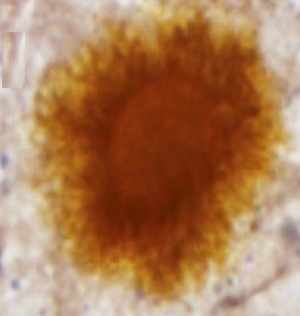

MedFriendly®


Hematoidin
Hematoidin is a type of yellow-brown or orange-red
pigment that is free from iron and made from hemoglobin.
Hemoglobin is a substance present in red blood cells that
help carry oxygen to cells in the body. Red blood cells are
cells that help carry oxygen in the blood. Hematoidin is
especially likely to be formed in the cells of tissues have
reduced or low levels of oxygen pressure. Hematoidin
closely resembles bilirubin, but is made in a different
location (see next paragraph). Bilirubin is a yellow-orange
substance found in bile. Bile is a bitter, yellow-green
substance released from the liver that carries away
waste products. The liver is the largest organ in the body
and is responsible for filtering (removing) harmful
chemical substances, producing important chemicals for
the body, and other important functions.
A hematoidin crystal.
FEATURED BOOK: Mosby's Diagnostic and Laboaratory Test Reference
Hematoidin is formed inside of cells, likely reticuloendothelial cells. Reticuloendothelial
cells are cells within the reticuloendothelial system, which is a collection of macrophages.
Macrophages are types of cells that ingest bacteria, foreign particles, and other cells.
Although hematoidin is made inside of these cells, they are also found outside of cells
after 5 to 7 days in the location of heavy uncontrollable bleeding. Too much hematoidin in
the blood produces the yellow appearance observed in jaundice. Jaundice is a yellow
staining of the skin, whites of the eyes, deeper tissues, mucous membranes, and waste
that is discharged from the body.
"Where Medical Information is Easy to Understand"™
A mucous membrane is one of four major types of thin sheets of
tissue that line or cover various parts of the body, such as the
mouth and passages for breathing. Hematoidin is a tiny, freely
moving substance and is capable of bending light. When looked at
under a microscope, it generally appears as a crystal or diamond-
shaped plate and is sometimes arranged in a radiating pattern.
Sometimes, however, hematoidin does not have a well-defined
shape.When hematoidin is present in the corpus luteum, it is known
as haemolutein. The corpus luteum is a sphere-shaped yellowish
structure on the surface of the ovary. Ovaries are organs in the
female body that normally produce eggs. Hematoidin is also known
as haematoidin, blood crystals, and hematoidin crystals.
The production of hematoidin is known as blood crystallization. Hematoidin comes from the Greek word
“haima” meaning “blood,” and the Greek word “eidos” meaning “resemblance.” Put the words together and
you have “blood resemblance.”















